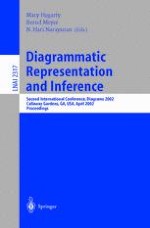2002 | Buch
Diagrammatic Representation and Inference
Second International Conference, Diagrams 2002 Callaway Gardens, GA, USA, April 18–20, 2002 Proceedings
herausgegeben von: Mary Hegarty, Bernd Meyer, N. Hari Narayanan
Verlag: Springer Berlin Heidelberg
Buchreihe : Lecture Notes in Computer Science
Enthalten in: Professional Book Archive
